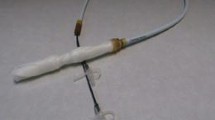Abstract
Background
Very few studies have reported results of the BioEnterics Intragastric Balloon (BIB®) at ≥12 months follow-up. The aim of this study is the retrospective evaluation of the results of BIB placement compared to diet regimen alone.
Methods
From January 2005 to June 2006, 130 outpatients underwent a structured diet plan with simple behavioral modification at our institutions. Controls (n = 130) were selected from the charts of patients who, during the same period, underwent BIB treatment. Patients in the outpatient group were given a structured balanced diet with a caloric intake between 1,000 and 1,200. The approximate macronutrient distribution, according the “Mediterranean diet,” was 25% protein (at least 60 g/day), 20–25% lipids, and 50–55% carbohydrates. In the BIB group, patients received generic counseling for eating behavior. In both groups, we considered weight loss parameters (kilograms, percentage of excess weight loss [%EWL], body mass index [BMI], percentage of excess BMI loss [%EBL]) at 6 and 24 months from baseline and comorbidities at baseline and after 24 months. Results are expressed as mean±standard deviation. Statistical analysis was done by Student’s t-test and χ 2-test or Fisher’s exact test. p < .05 was considered significant.
Results
At the time of BIB removal (6 months), significantly better results in terms of weight loss in kilograms (16.7 ± 4.7 vs. 6.6 ± 2.6; p < 0.01), BMI (35.4 ± 11.2 vs. 38.9 ± 12.1; p < 0.01), %EBL (38.5 ± 16.1 Vs 18.6 ± 14.3; p < 0.01), and %EWL (33.9 ± 18 vs. 24.3 ± 17.0; p < 0.01) were observed in patients treated by intragastric balloon as compared to diet-treated patients. At 24 months from baseline, patient dropout was 1/130 (0.7%) and 25/130 (19.2%) in the BIB and diet groups, respectively (p < 0.001). At this time, patients treated with intragastric balloon have tended to regain weight, whereas diet-treated patients have already regained most of lost weight.
Conclusions
Although the strength of this study may be limited by its retrospective design, the results indicate that, in the short-to-medium term, BIB is significantly superior to diet in terms of weight loss.
Similar content being viewed by others
References
Ramhadany EM, Fowler J, Baird JM. Effects of the gastric balloon versus sham procedure on weight loss in obese subjects. Gut. 1988;30:1054–7.
Wing RR. Behavioural treatment of severe obesity. Am J Clin Nutr. 1992;55:641–4.
Braunwell KD, Rodin J. Medical, metabolic and psychological effects of weight cycling. Arch Intern Med. 1994;194:1325–30.
Melissas J, Muozas J, Filis D, et al. The intragastric balloon. Smoothing the path to bariatric surgery. Obes Surg. 2006;16:897–902.
Hervé J, Wahlen CH, Schaeken A, et al. What becomes of patients one year after the intragastric balloon has been removed? Obes Surg. 2005;15:864–70.
Angrisani L, Lorenzo M, Borrelli V, Giuffré M, Fonderico C, Capece G. Is bariatric surgery necessary after intragastric balloon treatment? Obes Surg. 2006;16:1135–7.
Genco A, Cipriano M, Bacci V, et al. BioEnterics Intragastric Balloon (BIB): a double blind, randomised, controlled, cross-over study. Int J Obes. 2006;30:129–33.
Sallet JA, Marchesini JB, Paiva DS, et al. Brazilian multicenter study of the intragastric balloon. Obes Surg. 2004;14:991–8.
Busetto L, Enzi G, Inelmen EM, et al. Obstructive sleep apnea Syndrome in morbid obesity: effects of intragastric balloon. Chest. 2005;128:618–23.
Roman S, Napoleon B, Mion F, et al. Intragastric balloon for ‘non morbid’ obesity: a retrospective evaluation for tolerance and efficacy. Obes Surg. 2004;14:539–44.
Genco A, Bruni T, Doldi SB, et al. BioEnterics Intragastric Balloon: the Italian experience with 2,515 patients. Obes Surg. 2005;15:1161–4.
Alfalah H, Philippe B, Ghazal F, et al. Intragastric balloon for preoperative weight reduction in candidates for laparoscopic gastric bypass with massive obesity. Obes Surg. 2006;16:147–50.
Weiner R, Gutberlet H, Bockhorn H. Preparation of extremely obese patients for laparoscopic gastric banding by gastric balloon therapy. Obes Surg. 1999;9:261–4.
Busetto L, Segato G, De Luca M, et al. Preoperative weight loss by intragastric balloon in superobese patients treated with laparoscopic gastric banding: a case control study. Obes Surg. 2004;14:671–6.
Author information
Authors and Affiliations
Corresponding author
Rights and permissions
About this article
Cite this article
Genco, A., Balducci, S., Bacci, V. et al. Intragastric Balloon or Diet Alone? A Retrospective Evaluation. OBES SURG 18, 989–992 (2008). https://doi.org/10.1007/s11695-007-9383-9
Received:
Accepted:
Published:
Issue Date:
DOI: https://doi.org/10.1007/s11695-007-9383-9




